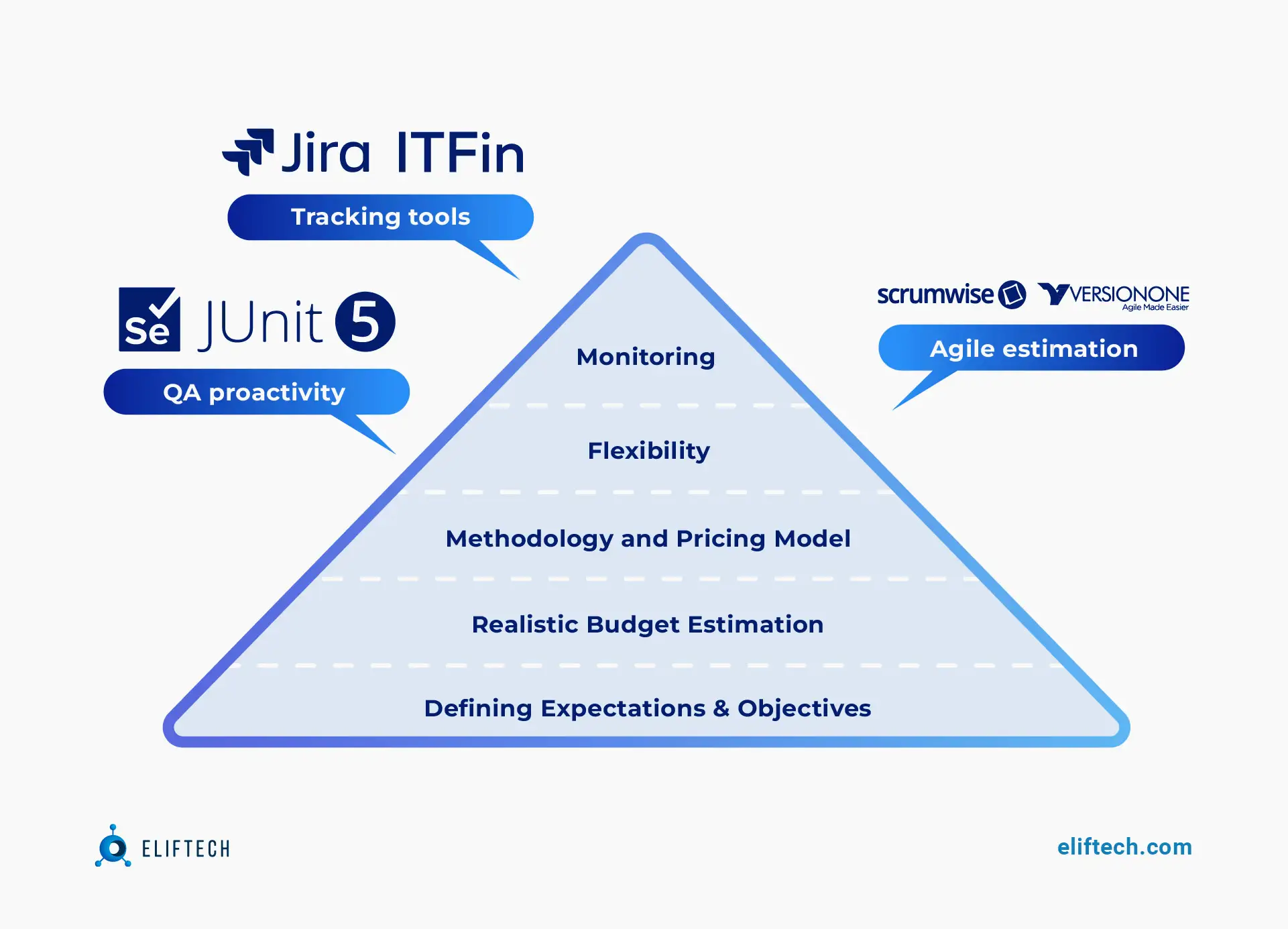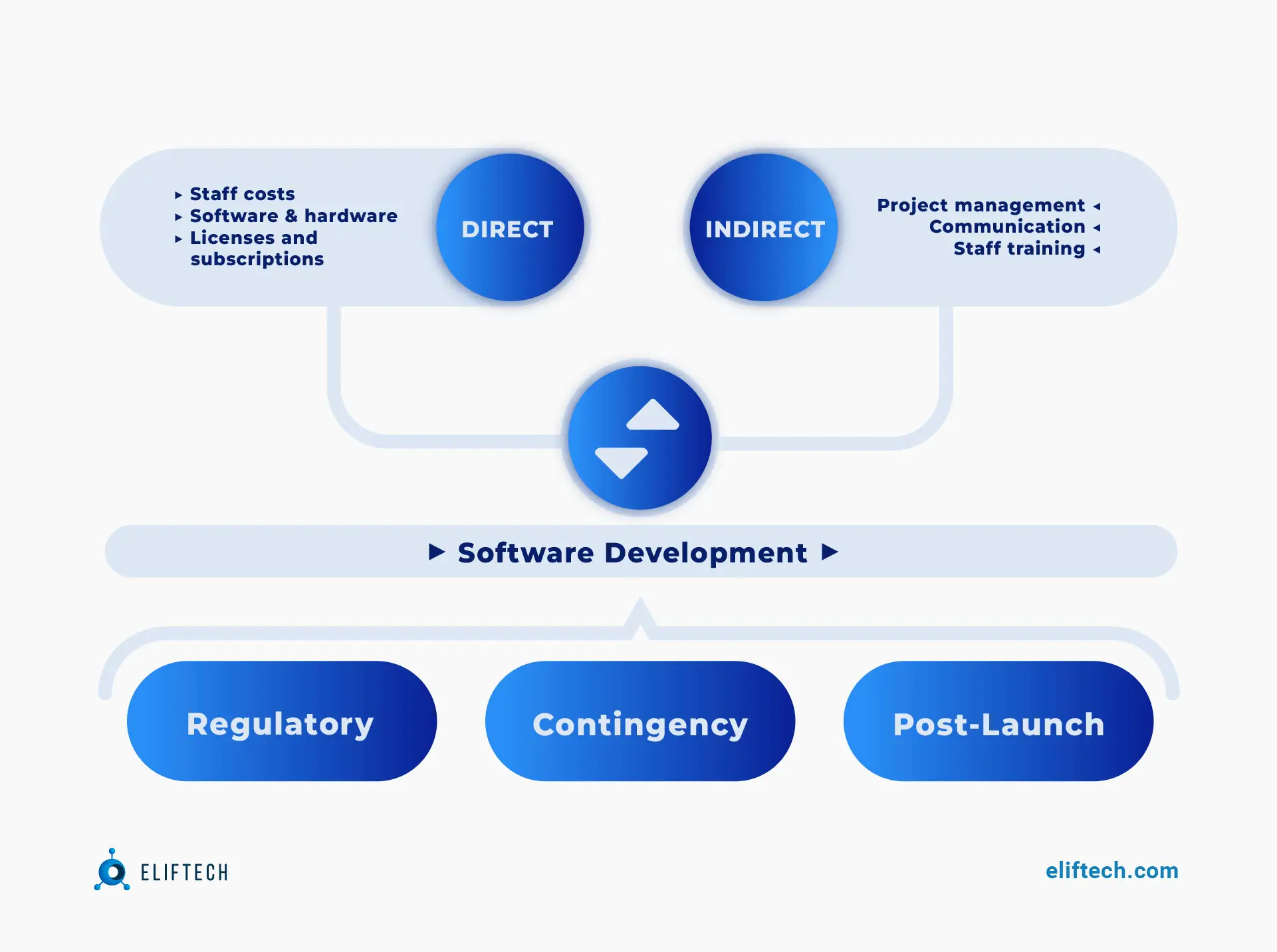Outsourcing
Custom Software Development Cost Guide (ElifTech Take)

Financial management in software development is indeed a tricky beast to navigate. Probably that is why many clients often switch between outsourcing companies just as they would change doctors, in hopes of finding somewhere they can put their trust back together.
Here's why this goes wrong so often – a lot of the time, software budgets are built on shaky ground. They're based on guesswork, unclear requirements, and communication that leaves a lot to be desired. These mistakes make 78% of companies either spend way too much or don't budget enough.
Given the precarious nature of financial management in software development, what common errors lead to budget estimations and how can they be avoided?
At ElifTech, we spent a good deal of time exploring project financial management through the lens of various best practices and actual experience on our projects. A decade-long rollercoaster ride in the fintech industry has given us a good workout in finance, making us speak both languages – software and finance. This expertise enables us to give customers complete control during projects. Here, we want to introduce you to the custom software development cost basics of how projects are estimated in our company and show some strategies to make it better.
Why is budget planning so important for development teams?
Now, of course, any project has at least some form of budget planning, but in many ways, it’s similar to parenting: people commonly go with their age-old instincts without considering the nature of the endeavor. As much as Victorian methods will likely not work on a modern TikTok-inspired child, our innate money-management skills will likely fail in software development. If only because there are things like Agile, the push for flexibility, and the market/overall business strategy fluctuations.
This means managing budgets in traditional ways is like raising a child in the wilderness – and using advanced and industry-specific techniques surely pays off.
While 78% of projects tend to go over budget (or violate deadlines), high-performing organizations are known to employ the more modern techniques to complete over 90% of projects on time, on budget, and on scope.
What gives?
Mainly, the ability to select the right paradigm for budget planning by first dissecting the project at hand in terms of its constituents, with clear objectives to measure progress. In fact, unclear objectives (coupled with bad planning that results) are a common cause of project failure, in 37% of cases in a study.
Every budget planning strategy out there, in turn, revolves around the general project strategy, the Definition of Done concepts used therein, and the approach to project iterations. Let’s explore the different strategies and see when they are best used.
The 5 strategies for custom software development cost planning
We’ve decided to split the checklist we’re about to provide into the strategic and the tactical part, the first focusing on the general considerations, and the second on the concrete steps.
However, one should bear in mind that the tactics won’t work without a strategy (e.g. implementing a particular tool won’t work if the general approach is the same), and the strategy is not about declarations, but rather about choosing the next step, which is tactics. With that in mind, let’s look at some of our best practices for custom software development cost planning.
#1 Shaping the expectations and objectives
By fostering open communication between stakeholders and development teams, organizations can align budgetary constraints with project goals. Defining realistic expectations ensures a transparent understanding of deliverables, timelines, and potential challenges. This necessarily proactive approach not only establishes a solid foundation for budgeting but also sets the stage for a collaborative development journey, where every investment aligns with strategic objectives and delivers measurable value.
#2 Being realistic about the actual budget
Acknowledging that software development is an evolving process allows for a more flexible budgeting strategy. Factor in contingencies for scope adjustments, emerging technologies, and quality assurance.
It’s also linked with the goals for the current (and subsequent) financial period – good budgeting implies prioritization and good outsourcing partners will always help out with that, considering the good client provides them with the business goals and the actual budget for the next several sprints. This ensures that the allocated budget is not only a financial estimate but a dynamic tool that adapts to the evolving nature of software development, ultimately leading to more accurate financial projections and successful project outcomes.
#3 Settle on the methodology and the model
The selection of a software development methodology significantly influences the choice of an outsourcing payment model. In the traditional Waterfall approach, where requirements are well-defined upfront, a fixed-price model aligns seamlessly. It offers clarity in costs and timelines, matching the structured nature of Waterfall. Conversely, Agile, with its iterative and adaptable nature, finds synergy with the time and material model. Agile's evolving requirements are better suited to a flexible payment structure, allowing adjustments based on ongoing changes and ensuring alignment between the chosen methodology and the outsourcing payment model for optimal project outcomes.
#4 Defining the “wiggle room”
As much as everyone wants to have a nice predictable budget, the very definition of “predictable” has changed, since the software is moving at its own pace. Incorporating "wiggle room" within budgets is indispensable. With Agile methodologies emphasizing flexibility and iterative cycles, unforeseen challenges and evolving requirements are inherent. Allocating a portion of the budget for contingencies, unexpected changes, and robust quality assurance ensures a safety net for any unanticipated hiccups. This strategic approach not only guards against potential cost overruns but also allows for innovation and continuous improvement without compromising project timelines. In essence, embracing wiggle room isn't just about preparing for the unexpected; it's a proactive strategy that fosters adaptability, transparency, and the successful realization of project goals within budget constraints.
#5 Setting up monitoring routines
Establishing robust monitoring routines is pivotal in the realm of software development budget planning. Regular and systematic tracking of project expenditures against the budget allows for early identification of potential deviations. Implementing KPIs and financial metrics creates a proactive environment, enabling teams to address issues promptly. Continuous monitoring facilitates real-time adjustments, ensuring that the budget remains aligned with project progress and objectives. Moreover, it fosters transparency with stakeholders, instilling confidence in the financial integrity of the project. In essence, setting up monitoring routines isn't just about oversight; it's a strategic practice that empowers teams to navigate the intricacies of software development with financial prudence and project success at the forefront.

The 5 tactics for custom software development costs plan
These are the tactics (as opposed to strategies) that our teams at ElifTech use for custom software development cost planning to help customers optimize budgets for different projects. A disclaimer: none of these could be called a panacea without a sound strategic basis, but they are powerful tools to use along the way.
- Tracking tools like JIRA: used to document and manage requirements collaboratively.
- Agile estimation techniques and tools: methods like story points or planning poker can be used for more accurate and flexible budgeting, alongside Agile project management tools (e.g., Scrumwise, VersionOne) to facilitate collaborative estimation and planning.
- Time tracking: while there is not always a real need to use these, sometimes it’s a good idea to see where the “black holes” are that suck in most of the teams’ paid time (Harvest, Toggl).
- Budgeting and forecasting tools (e.g., Float, Forecast) can help track expenditures against the allocated budget in real time.
- Proactively handling QA expenses: investing in quality assurance and testing tools (e.g., Selenium, JUnit) can help minimize the risk of defects and costly rework.
Some planning tools, like ITFin, consolidate various essential aspects of financial management. It offers detailed time tracking, an innovative hiring management system, and several other features that cater to the needs of tech businesses. For a deeper understanding of its extensive capabilities, explore the case study that sheds light on ITFin's development and benefits.
Custom software development costs you should consider
When focusing on the financial aspects of software development, paramount consideration must be given to the various costs that tend to emerge during the project's lifecycle. These costs often go beyond the initial estimation and require appropriate management to maintain budgetary control. Here are the main cost categories to consider.
Direct development costs
These are the core costs associated directly with the actual development of the software. They typically include:
- Staff costs: Salaries of the development team, including software engineers, UX/UI designers, project managers, and testers.
- Software & hardware: Costs of required tools, IDEs (Integrated Development Environment), specialized hardware, and other resources required for the efficient functioning of the team.
- Licenses and subscriptions: This includes costs related to operating system licenses, costs of using specific development software or platforms, cloud services, and third-party APIs.
Indirect development costs
These costs might not be directly involved in the development process but have a significant effect on the overall project's success:
- Project management: Time spent by project managers on overseeing the project, coordinating team efforts, and managing expectations.
- Communication: This includes the time and resources spent on meetings, correspondence, and any other form of project-related communication.
- Staff training: Invested in upskilling the team to ensure that they are able to use the required tools and technologies.

Contingency costs
In addition to direct and indirect costs, there will most likely be unexpected expenditures that arise during the project life cycle. Having a contingency budget in place to manage these costs can save a project from going over budget. It is typically recommended to set aside 10-20% of the total project budget for such circumstances.
Post-launch costs
Even after successfully launching the software, there will be ongoing costs to consider:
- Maintenance and upgrades: The software will need regular updates and bug fixes to keep it running smoothly.
- Customer support: Providing support to users is critical for maintaining the reputation and usage of the software.
- Marketing and sales: You need to have a strong marketing strategy for your software, and this will further add up to the costs.
Regulatory compliance costs
Depending on the software’s nature, there might be costs related to meeting specific industry or legal standards. For example, software in the healthcare sector would need to comply with HIPAA standards, which would add to the budget.
Understanding these costs is the first step in having an accurate budget plan. Each project will have unique requirements, and thus, careful and precise planning is needed to ensure all costs are captured in the initial budgeting phase. At ElifTech, we focus on providing detailed cost breakdowns, giving clients more control over their project's financial health and boosting confidence in our services.
All custom software development costs are supposed to be clearly articulated
With so many costs and aspects involved, some clients may find it challenging to navigate these costs or understand the expense of specific tools. Lack of transparency here often results in project failure 30% of the time within organizations.
If cost articulation is insufficiently detailed or delayed, clients may feel misrepresented. This discomfort often is the exact reason that compels them to seek more transparent service providers.
Therefore, it's essential from the outset to provide a clear, accurate vision of all potential costs with financial management software or cost estimation calculators, breaking down costs into detailed components, built upon trust, and leveraging the expertise of financial analysts and project managers.
One of the good practices in this regard is the inclusion of cost calculators by outsourcing agencies. While, of course, claiming to be able to calculate the cost of a project without actually talking to the client first, is not realistic, calculators allow professionals to approximate the actual cost and lay a solid foundation for the initial budget. ElifTech also employs this convenient option:
Moreover, any "opaque" aspects must be promptly and fully addressed by project managers throughout the entire project lifecycle. This plays a pivotal role in establishing effective communication that involves reciprocating feedback between clients and project managers.
Indeed, communication within a project isn't an isolated instance – it's an entire field of study in itself if you want! Believe it or not, we often find within our projects that clients might refrain from voicing their feedback or prefer to voice it to one or two select individuals. This could be attributed to a variety of reasons, and to understand why, we would probably need to delve into the realm of psychology. However, navigating this delicate situation calls for fostering an environment that promotes open and constructive feedback.
For example, our project managers facilitate regular feedback sessions, assuring clients that their input, regardless of its nature, is critical for the project's success. This approach reassures clients and encourages transparency, leading to continuous improvement and the building of mutual trust.
Now, why us as your software development partner?
In conclusion, it’s really about business planning, as well as understanding between the client and the vendor. From meticulous scope definition and Agile methodologies to diligent monitoring and cutting-edge tools, the pillars of effective budgeting are multifaceted. It's not merely about financial constraints but rather a strategic roadmap that aligns resources with project goals.
As you navigate the intricacies of outsourcing, consider partnering with ElifTech, where budgeting isn't just a task—it's a strategy. Our commitment to transparency, Agile practices, and state-of-the-art tools ensures that your project not only meets financial expectations but also delivers exceptional value.
When it comes to calculating custom software development cost for a project, we adhere to 3 fundamental principles to ensure transparency and mutual trust:
- We ensure that every project element and its associated costs are clearly communicated. This facilitates accurate budget planning and keeps all parties informed on where and how resources are being allocated.
- We integrate client feedback into our project lifecycle through regular checkpoints. These intervals serve as crucial opportunities for us to glean insights, promptly address any issues or concerns, and iterate on our strategy. If a lack of clarity or concern arises on the client's end, our dedicated team immediately steps in to provide understanding or enact indispensable adjustments to ensure the project's continuous smooth operation.
- Sticking to agile to accommodate changes effectively, keeping projects within budget while still meeting desired objectives.
Let ElifTech be your ally in the journey of transformative, budget-conscious software development. If you have an innovative idea, turn your visions into reality by employing our handy project cost estimator to get the first estimate of your project. Our team will contact you very soon to confirm these estimates and guide you through the next steps of your development journey.
